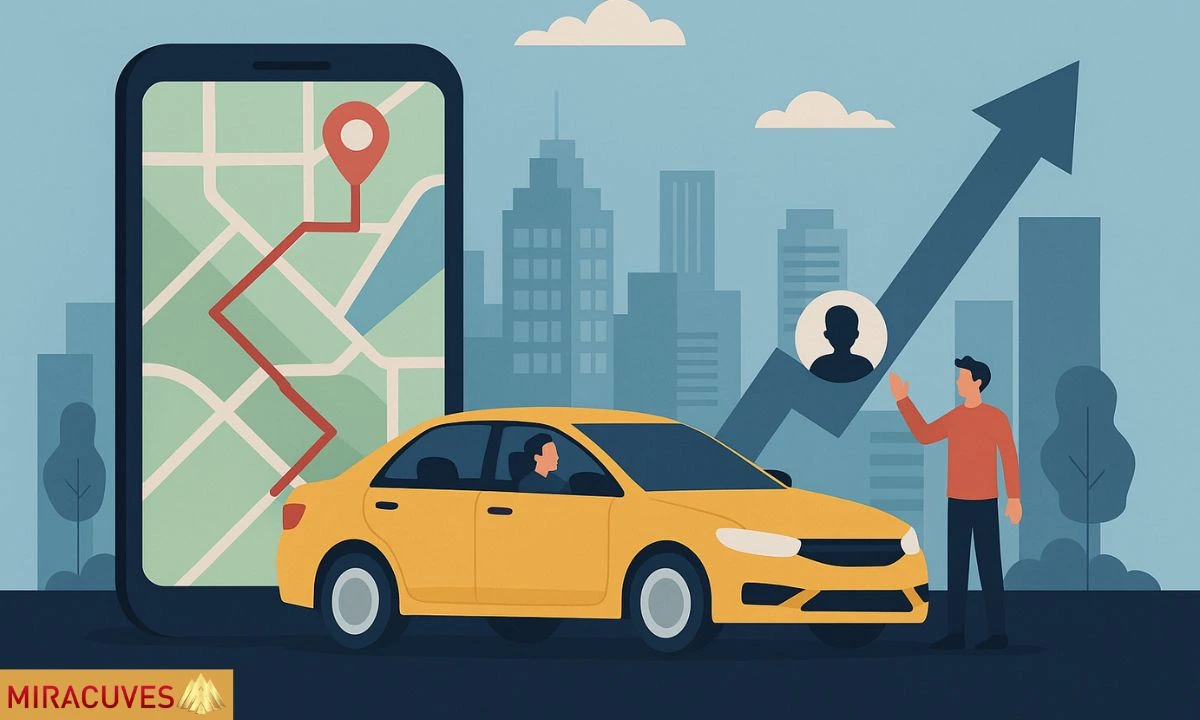Uber didn’t just change how we move — it redefined how the on-demand economy works. From solo rides to shared commutes and even food delivery, Uber built a platform that thrives on simplicity, speed, and scale.
But behind the sleek app interface is a powerful business model that millions of startup founders try to replicate. Why? Because it blends real-time logistics, asset-light operations, and scalable revenue streams — all in one seamless experience.
In this blog, we’ll break down the business model of Uber in 2025, explore how it generates revenue globally, and show how you can launch your own Uber-like app with a proven framework — faster and smarter with Miracuves.
What is Uber & How It Works
Uber is an on-demand ride-hailing platform that connects passengers with drivers through a mobile app — but it’s more than just a way to book a cab.
At its core, Uber acts as a real-time logistics network, matching supply (drivers) with demand (riders) using location data, dynamic pricing, and seamless payment systems. Users open the app, enter their destination, choose a ride option, and get matched with the nearest available driver. Payment happens automatically — no cash, no haggling.
In 2025, Uber’s ecosystem has evolved far beyond basic rides:
- UberX for budget travel
- UberXL for group rides
- UberGreen for eco-conscious users
- UberMoto for two-wheeler mobility
- UberEats for food delivery
- Uber for Business to serve enterprises
This diversity allows Uber to maximize user engagement across use cases, while keeping all revenue within one ecosystem.
Who Uses Uber (Target Users & Audience)
Uber’s success lies in its ability to serve a diverse, global user base — and that’s exactly what makes it such a powerful business model to replicate.
Uber’s Primary User Segments:
- Commuters
Daily users who rely on Uber for office-to-home travel or city navigation. - Occasional Travelers
Airport pickups, weekend outings, or intercity travel — especially in unfamiliar places. - Tourists & Visitors
Users in new cities who want quick, trusted local transport. - Students & Young Adults
Cost-conscious users who prefer options like UberMoto or ride-sharing. - Corporate Clients
Businesses using Uber for Business for employee transport and expense tracking. - Delivery Customers
Through UberEats, users order food, groceries, or even medicine. - Drivers & Delivery Partners (Platform Side)
Individuals looking for flexible income without full-time employment.
This wide audience means Uber isn’t just a transport service — it’s a daily utility for millions. For clone founders, this translates to multiple entry points for monetization, retention, and user growth.
Core Features That Power Uber’s Business Model
Uber isn’t just a taxi app — it’s a feature-driven platform that uses technology to optimize user experience, reduce friction, and create monetization opportunities at every step.
Here are the features that keep Uber running like a well-oiled machine in 2025:
Key Features:
- Real-Time GPS Tracking
Enables live driver and rider tracking, boosting trust and convenience. - Smart Matching Algorithm
Instantly connects users with the nearest available driver for minimal wait time. - Dynamic Pricing (Surge Fare)
Adjusts pricing based on demand, increasing revenue during peak hours. - In-App Payments
Seamless, cashless transactions with multiple payment modes including wallets, cards, UPI, and now even crypto in some markets. - Multiple Ride Options
UberX, UberXL, UberMoto, UberGreen — offering tiered pricing for different budgets. - Driver & Rider Ratings System
Two-way feedback loop that ensures service quality and accountability. - Promotions & Loyalty Programs
Discounts, ride passes, and Uber rewards that retain users and increase ride frequency. - In-App Chat & SOS Safety Features
Allows direct rider-driver communication and quick access to emergency help — critical for user trust.
These features aren’t just functional — they are revenue enablers. From surge pricing to premium ride types, each feature is designed to either generate more revenue or retain users longer.
Revenue Streams – How Uber Makes Money in 2025
Uber doesn’t own cars. It doesn’t employ drivers. Yet it generates billions in revenue. How? By being the platform that connects supply and demand — and taking a cut at every intersection.
Here’s a breakdown of Uber’s revenue streams in 2025:
| Revenue Stream | How It Works |
|---|---|
| Ride Commissions | Uber takes 15–30% commission from each ride booked through its platform. |
| Surge Pricing | During high demand, Uber increases fare prices dynamically — boosting revenue. |
| UberEats Delivery Fees | Charges customers a delivery fee + commission from restaurants (15–25%). |
| Subscription Plans | Uber Pass / Uber One offers benefits for a monthly fee, improving retention. |
| Corporate Accounts | Uber for Business charges enterprises for managing employee travel. |
| Cancellation/Waiting Fees | Additional charges when users cancel late or delay pickup. |
| Advertising & Promotions | New ad placements within the app for restaurants and local services. |
| Leasing Programs | In some markets, Uber partners to lease vehicles to drivers for a weekly fee. |
Key Insight for Founders:
Uber’s strength lies in modular monetization — not one giant stream, but many small, scalable ones. When cloned, each stream can be adapted or even replaced based on market needs.
Cost Structure – What Keeps Uber’s Engine Running
While Uber follows an asset-light model (it doesn’t own cars or hire drivers), it still has substantial operational costs to manage its global ecosystem. Understanding this is crucial for founders aiming to replicate or optimize the model.
Here are the primary cost components Uber manages:
Key Cost Buckets
- Technology & App Infrastructure
- Cloud hosting (AWS, GCP), real-time mapping, data analytics, AI algorithms
- Ongoing development, testing, and maintenance across iOS, Android, and web
- Customer Support & Safety Operations
- 24/7 help centers, in-app support, SOS integrations, trust & safety teams
- Driver & Partner Incentives
- Referral bonuses, guaranteed earnings, loyalty bonuses to keep supply healthy
- Marketing & User Acquisition
- Paid ads, referral programs, offline promos, event partnerships
- Regulatory & Compliance Costs
- Legal fees, local government taxes, insurance contributions
- Research & Expansion
- Testing new markets, piloting new services (e.g., UberBoat, autonomous rides)
- Admin & Corporate Overheads
- Office expenses, executive salaries, financial services, global payroll
Founder Insight:
A successful Uber-like clone isn’t just about copying the tech — it’s about designing a lean cost model that fits your geography, driver economics, and service offerings.
2025 Innovations & Strategic Shifts in Uber’s Business Model
As mobility trends evolve, Uber continues to adapt. In 2025, the company isn’t just a ride-hailing giant — it’s a multi-service logistics engine exploring automation, sustainability, and embedded commerce.
Here are the key changes in how Uber is operating and monetizing in 2025:
Notable Shifts & Additions:
- Hybrid Monetization Models
- In emerging markets, Uber now mixes freemium rides with in-app ads, allowing users to take discounted rides in exchange for ad exposure.
- Uber Ads Platform
- Restaurants, local brands, and even global partners can now advertise inside the Uber app, opening a powerful new revenue stream without affecting the core UX.
- Green Mobility Push
- UberGreen and UberElectric gain traction as governments push carbon-neutral mandates. Electric vehicle incentives now drive platform loyalty among eco-conscious users.
- Embedded Finance Features
- Uber Wallet allows users and drivers to save earnings, get instant cashouts, and even earn interest — creating a fintech layer over its mobility ecosystem.
- Subscription Stack Expansion
- Uber One now bundles rides, delivery, and grocery in one premium pass — pushing cross-vertical user retention.
- AI-Driven Smart Routing
- New updates use AI to reduce driver idle time, predict demand zones, and auto-assign deliveries, cutting cost and improving efficiency.
Why Founders Should Care:
These shifts aren’t just trends — they’re future-proofing strategies. If you’re launching an Uber-like app today, integrating even 2–3 of these innovations could give you a serious competitive edge.
Takeaways for Founders Looking to Clone Uber
Cloning Uber isn’t about copying its design — it’s about understanding its mechanics and applying them to your own market with speed, clarity, and customization.
Here’s what every founder should learn from Uber’s model:
Key Founder Insights:
- Platform Power > Asset Ownership
Uber’s success lies in building a scalable platform, not owning cars or hiring drivers. Focus on the tech, not the inventory. - Multiple Revenue Streams Create Stability
Commissions, ads, subscriptions, cancellation fees — every stream adds up. A good clone doesn’t rely on one channel. - Feature Customization is Key
Your Uber-like app doesn’t need all of Uber’s features. Pick the ones that matter to your local market: Moto in India, Premium in the US, Green in Europe. - Trust & Safety = Long-Term Retention
Two-way reviews, SOS, live tracking — these aren’t just UX features. They build emotional trust, which is priceless in mobility. - Tech Stack Matters
Real-time updates, low-latency routing, secure payment systems — without a strong backend, even a beautiful app will fail. - You Don’t Need $1B to Compete — Just the Right Dev Partner
Uber started as a local black car service. What made it explode was not funding, but execution. That’s where Miracuves comes in.
Miracuves Insight:
You bring the idea. We bring the Uber-level logic, scalable backend, and market-ready design — delivered faster, smarter, and built for growth.
Conclusion: Ready to Build the Next Uber?
Uber didn’t succeed by accident — it nailed the business model, scaled with tech, and adapted with time. As we’ve seen, its 2025 strategy is sharper than ever, powered by real-time logistics, modular revenue streams, and trust-first UX.
If you’re a founder, investor, or digital agency looking to launch something similar — now is your moment. The on-demand economy is thriving, and the infrastructure to build fast, flexible, Uber-like apps already exists.
Build Your Uber-Style App with Miracuves
At Miracuves, we don’t just build clones — we engineer digital business models.
From real-time ride matching to multi-country fare logic, we help you launch an app that works like Uber, but feels like yours. Scalable, branded, and market-ready — without wasting months or millions.
Talk to our team and let’s bring your mobility vision to life.
FAQs
How does Uber make money in 2025?
Uber earns revenue through multiple channels including ride commissions, dynamic (surge) pricing, food delivery via UberEats, corporate ride packages, in-app advertisements, and subscription plans like Uber One. Each of these adds to a diversified and scalable revenue model.
Is Uber profitable today?
Uber has been gradually moving toward profitability with strong earnings in certain regions, especially after restructuring its operations and scaling its advertising and subscription services. However, it continues to invest in new verticals like autonomous driving and embedded finance.
Can I build an app like Uber for my local market?
Absolutely. With the right development partner, you can launch a market-tailored Uber-like app that suits local needs — such as two-wheeler rides, regional languages, or wallet-based payments. Platforms like Miracuves offer ready-to-customize clone solutions that speed up launch time.
What makes Uber’s business model successful?
Its strength lies in being a platform, not a service provider. Uber connects drivers and riders without owning the vehicles, allowing it to scale across cities and countries without heavy capital investment — while monetizing through multiple channels.
What’s the tech stack behind Uber’s platform?
Uber uses a combination of real-time GPS, route optimization algorithms, cloud computing (AWS/GCP), scalable APIs, secure payment gateways, and machine learning for demand forecasting. Miracuves offers similar backend flexibility using Node.js, React, Laravel, and other proven stacks.








